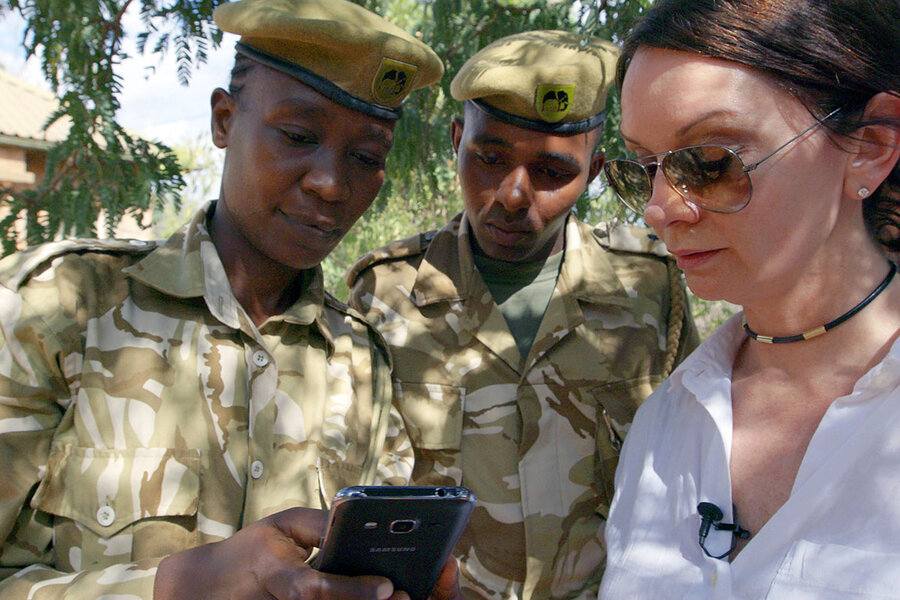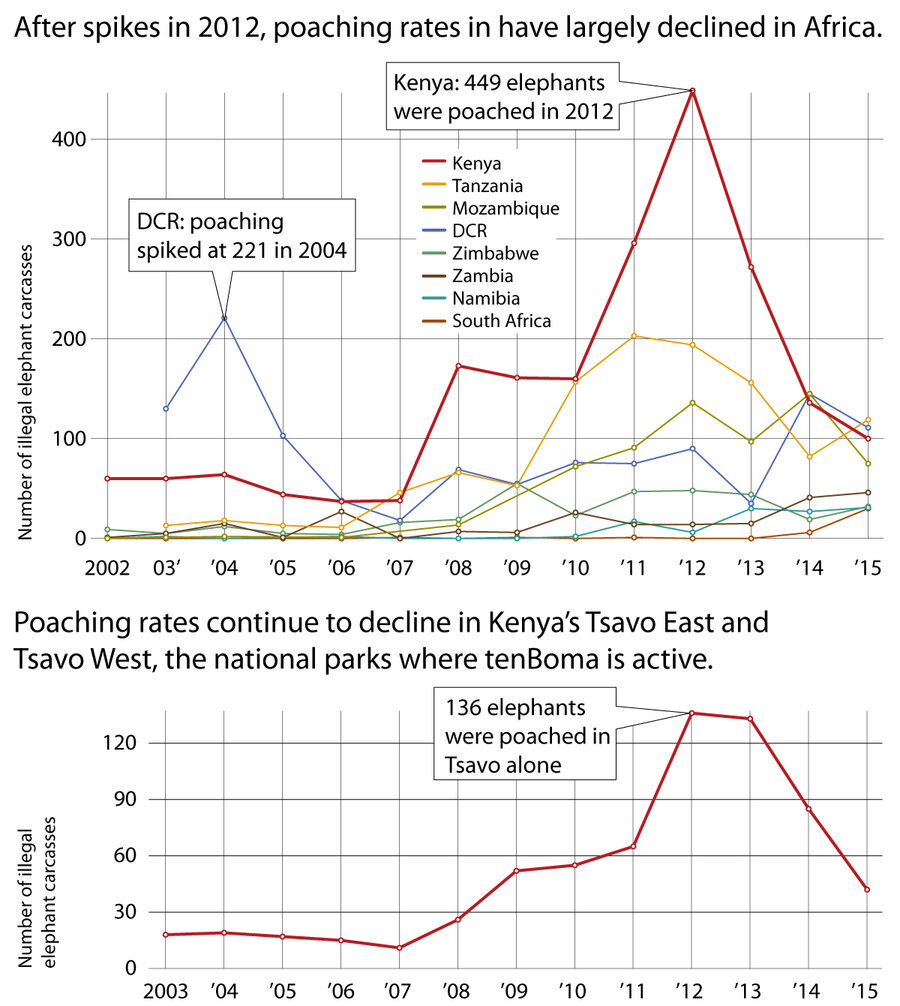From ISIS to elephants: the tale of a unique anti-poaching force
Loading...
| Boston
Lt. Col. Faye Cuevas says the two decades she spent fighting terror networks was the perfect preparation for her current job: saving elephants in Kenya.
Intelligence missions, including the 2006 kidnapping of Christian Science Monitor reporter Jill Carroll, taught the US Air Force officer that classified intelligence is “only one piece of the puzzle.” She and other intelligence support officers learned to look for nontraditional clues when assessing the security of an area. It was in Africa, while working on a mission targeting the Lord’s Resistance Army, that she first started relying on the intuition of elephants.
The presence of elephants, it turned out, was a surprisingly reliable indicator of an area’s safety. During migration, elephants follow paths etched in memory, but they adjust those routes to avoid areas that they sense may be unsafe. By studying the movements of elephant herds, she was able to help keep the members of her unit safe.
She left active duty to return the favor. If clues from the natural world add nuance to information gathered from sophisticated intelligence streams employed by the military, perhaps military technology and strategy could help inform the fight against poaching.
“There were hard-fought and valuable lessons learned from Iraq and Afghanistan that we could apply to achieve a more disruptive effect [in poaching],” says Cuevas. “Whether you are in Al Qaeda or ISIL, you have to have a local network that you tap into and it works the same for [the] wildlife network. It is a constellation of actors.”
To better understand those actors, Cuevas has brought cutting-edge technology more commonly associated with modern warfare to the anti-poaching fight. The same geospatial mapping techniques and data analysis used by the US military to fight terrorism are now being deployed in a sophisticated offense to rival poachers’ criminal networks.
And those efforts appear to be paying off. Between May and September, with the help of the Kenya Wildlife Service (KWS), Cuevas's group the International Fund for Animal Welfare (IFAW) facilitated the arrest of 21 suspects during counter-poaching operations. Together, the two groups helped reduce poaching in Kenya's Tsavo National Parks by 43 percent from 2015 to 2017. In some previous hotspots, poaching appears to have ceased entirely.
Other groups borrow from military protocols to combat poaching as well, but many of those efforts focus on launching an all-out war on poaching, complete with gun battles. Critics of that approach caution that “green militarization” encourages an arms race and marginalizes impoverished communities. Others say counter-poaching efforts should focus on reducing demand for ivory in Asia.
Cuevas says her approach is different because it works directly with local communities and relies more on data than weaponry.
“Data and information are the new ammunition,” says Cuevas, in a video produced by IFAW, where she is a senior vice president.
Cuevas started working for the IFAW two years ago. The group is headquartered in Yarmouth Port, Mass., but Cuevas now lives in Nairobi, where she leads the organization’s tenBoma program in the Tsavo Parks.
The program borrows from a community policing philosophy known as nyumba kumi, or “10 houses” that look out for one another, similar to a neighborhood watch. TenBoma merges that idea with the Swahili concept of boma, which refers to an open area of bush that offers shelter and safety. The program’s mission is to improve information sharing among disparate anti-poaching efforts and to carve out a network of safe spaces for elephants among Kenya’s national parks and surrounding areas.
‘Left of the Kill’
Halfway around the world in Boston, Cuevas and IFAW president Azzedine Downes offered a glimpse into the thinking behind the group’s current strategy at the city’s HUB Week ideas festival earlier this month.
Mr. Downes began his speech by telling the audience that one elephant is killed every 15 minutes for its ivory.
“During this talk, four elephants will be killed,” he told the somber crowd. At this rate, he added, elephants may be extinct in 10 years – a timeframe that has been tossed around by other conservationists.
And while the demand for ivory needs to be discouraged, said Downes, conservationists need to take this poaching rate seriously and stop the kill before it happens. That’s where Cuevas’s military experience comes in.
While in Iraq in 2005, Cuevas says she witnessed one of the most successful counterterrorism strategies she's seen. It arose from the ability to zoom out and address the context of a chronic threat, in this case improvised explosive devices (IEDs) scattered along the roadside.
As IED prevention efforts stalled, generals in Baghdad told Lt. Gen. Peter Chiarelli that they needed more equipment to get “left of the boom” because the small bombs could easily be hidden in street garbage.
“Chiarelli said, ‘Well, let’s pick up the garbage then,’ ” Cuevas recalled.
“That's what I fixated on: How can we deny the poachers operational space?” Downes said. “We can't let the bombs go off and then chase the bad guys. We have to ... stay working on the side of the explosion before it happens. So we started thinking, how do we get ‘left of the kill?’ ”
By zooming out its focus and incorporating broad data analysis, IFAW began to spot seemingly unrelated patterns that could signal that poachers had moved into an area before they actually made a strike.
“[We] map out layer upon layer upon layer, and think in ways that a typical conservation group would not think,” Downes explained. Eventually, “a pattern emerges.”
One pattern that emerged was a spike in petty crime, such as theft of tea or food from nearby communities, prior to a big hunt. Another pointed to increased traffic at motorcycle repair shops as poachers had their bikes checked before heading out into the bush.
IFAW also monitors communities’ relationships with nearby elephants. If particular elephants have been damaging a family’s crops, their community may be less likely to share tips with rangers.
Game the change
Historically, militarized anti-poaching efforts have fostered mistrust of conservationists among local communities, says Libby Lunstrum, an associate professor of geography at York University in Toronto who has studied poaching in South Africa since 2003.
Poachers need to have an understanding of the area, which means they often have ties to nearby villages. Local sympathy to conservation efforts may harden if a neighbor’s son, for instance, is killed by rangers for suspicious activity. Instead of pushing for bigger guns, Professor Lunstrum says conservationists need to focus on the economic circumstances that drive poachers to poach in the first place.
“Militarized approaches don't take reality of poverty seriously. It is more of a short-term response,” says Lunstrum. “It's about seeing the poachers as a part of the communities.”
But it's hard to have it both ways, says Francis Massé, also a poaching researcher at York University.
“Taking a military approach on one hand and trying to do community work on the other hand, it's kind of a contradiction,” says Mr. Massé. “There is a tension around trying to do both.”
But Cuevas says there is a difference between weaponization and the military tactics she is working to implement from the ground up, with community leadership.
There is a line, adds Downes, and he is careful not to cross it. IFAW has not, and does not plan to, create its own private militia to stop poaching – “Something that is rightly criticized,” says Downes, and that invites more conflict to highly politicized conflict areas. Instead, his organization embeds trained officials into existing law enforcement and park protection services to combat violence that he says already exists.
IFAW is gearing up to expand tenBoma into Malawi and Zambia in December, and eventually plans to bring the program to the Periyar Tiger Reserve in India.
Time is running out to identify the single game changer that is going to flip the script, says Cuevas. “It is time to bring all those game changers together in a collaborative environment, because it is time to game the change. We don’t want to be the generation that lost the elephants.”











